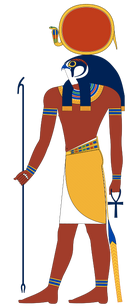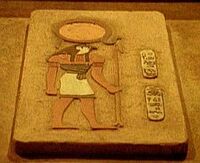
In one of his many forms, the Egyptian sun-god Ra has the head of a falcon and the sun-disk of Wadjet resting on his head.
<hiero>r:a-N5:Z1-C2</hiero>
Ra's name in hieroglyphs
Ra (also spelled Ré) is the ancient Egyptian sun god. The meaning of the name is uncertain, but it is thought that, if ra is not itself a word for "sun", then it may be a variant of a root meaning "creative". To all ancient peoples, the sun brought light, warmth, and growth, making sun deities very important. In the myths about Ra, the sun is either seen as the body or the eye of the god.
The flashback in the third season episode, "Ashes to Ashes", is set in Egypt. LaCroix's daughter/master, Divia, takes him to the Tomb of Aya-Hotep. This is extensively decorated with wall paintings, with one particularly large one of Ra in his sun-chariot. In addition, there are sarcophagi, the middle one having a carving of Ra on the lid. Divia tells LaCroix that she placed her master, Qa'ra, inside this sarcophagus after killing him.
Divia tries to persuade LaCroix to commit incest with her. Horrified at the thought, he beheads her and puts her body inside the sarcophagus. The seal of Ra on the lid serves to lock her inside for almost two millennia. However, at the beginning of "Ashes to Ashes", a tomb robber breaks the lid open, and Divia is released.
Egyptian Sun Myth[]

In "Ashes to Ashes", there is a painting of Ra in his solar boat on the end wall of the Tomb of Aya-Hotep.
In Egyptian myth, the sun god travelled across the sky by day, and returned to the east at night by going underground. However, this meant navigating the primordial waters of the underworld. In order to protect the sun's fires from the water, it was necessary for Ra to journey on a solar boat called the Mandjet (The Boat of the Millions or, alternatively, the Boat of Millions of Years). With him in the sun boat were various other deities to help defend against the monsters of the underworld. Chief among these was Apep, an enormous serpent that threatened each night to consume the sun and plunge the world into darkness.
Alternatively, some ancient Egyptians believed that, as the sun set every night, Ra died. The Mandjet barque on which he travelled during the day then turned into the Mesektet barge (the Night-barge) that carried Ra through the underworld back towards the east in preparation for his rebirth at sunrise. In these myths of Ra, sunrise is seen as the daily rebirth of the sun from the sky goddess Nut. This adds concepts of rebirth and renewal to the sun myths, strengthening Ra's role as a creator god.
History of the Worship of Ra[]

The central sarcophagus in the Tomb of Aya-Hotep has the symbol of the sun god, Ra, carved onto the lid.
The local cult of Ra began to grow from roughly the second dynasty (c. 3000 B.C.), establishing Ra as a sun deity. By the fourth dynasty (c. 2575-2467 B.C.), the pharaohs were identified as Ra's manifestations on earth, and referred to as "Sons of Ra". His worship increased massively in the fifth dynasty (c. 2498-2345 B.C.), when he became a state deity. Pharaohs had specially aligned pyramids, obelisks, and solar temples built in his honour. During this period, Ra was identified primarily with the mid-day sun, with other deities representing other positions of the sun. However, later he was said to represent the sun at all times of the day.
Though worship of Ra was widespread, the chief cult centre of Ra was first based in Heliopolis (called Inun, "Place of Pillars", in Egyptian) in Lower Egypt, where he was identified with the local sun-god Atum. In the Old Kingdom, the Egyptians believed that Atum lifted the dead king's soul from his pyramid to the starry heavens. The Atum mythos became merged in the Egyptian pantheon with that of Ra, who was also a creator god and a solar deity: the two identities were joined into Atum-Ra.
Ra was later also merged with the god Horus, as Ra-Horakhty ("Ra, who is Horus of the Two Horizons"). Horus was the oldest and most significant of the deities in the Ancient Egyptian religion. The earliest recorded form of this god is "Horus the Falcon", who was the patron deity of Nekhen in Upper Egypt, and evolved into the first known national god: pharaohs came to be regarded as being a living manifestation of Horus. Horus was a sky god, and therefore was considered to contain also the sun and moon. The merged god, Ra-Horakhty, commanded the sky, the earth, and the underworld. He also took over the associations with the falcon, which became the symbol of any sun deity who protected the pharaohs.
Still later, Ra was identified with the god Amun. In early times, Amun symbolized creative force. As creator, he was seen as the underlying substance of the world, with the deities and all things of the world being made of his flesh. As he was believed to create via breath, he was identified with the wind rather than the sun. However, in Thebes, Amun came by extension to be associated with the breath of life; and thus he was considered to be one of the deities who created part of the ba (soul). In the period of the New Kingdom (1550-1292 B.C.), Thebes became the most important city in Egypt; and, with its rise, came an increased importance for Amun. He became identified with the chief deity who was worshipped in other areas during that period, Ra-Horakhty. This identification led to another merger of identities, with Amun becoming Amun-Ra.
During the New Kingdom, the walls of tombs were used to display detailed texts describing Ra's journey through the underworld.
The rise of Christianity in the Roman empire caused an end to the worship of Ra by the citizens of Egypt, and as Ra's popularity suddenly died out, the study of the god became purely a matter of academic knowledge even among Egyptian priests.
- Adapted from the Wikipedia article on Ra.